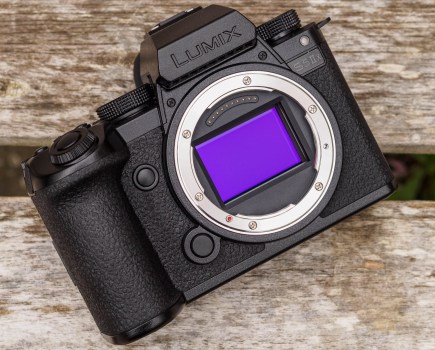The Sad Clown by Joan de la Malla, Spain
(Winner, Wildlife Photojournalism)
Chosen by Adrian Johnson
“The Sad Clown” by Joan de la Malla creates an incredible communication of feeling between a suffering animal (a long-tailed macaque) and the viewer. Looking at it, I feel as I would if this monkey were one of my children or grandchildren. Its hand is raised in suffering and despair, while its keeper seems to be unaware or uncaring. Any photograph of ill-treatment is disturbing, but through this picture we can so personally relate to the macaque’s hopelessness, bringing greater awareness of the situation for these creatures, and a desire to act on their behalf. www.joandelamalla.com
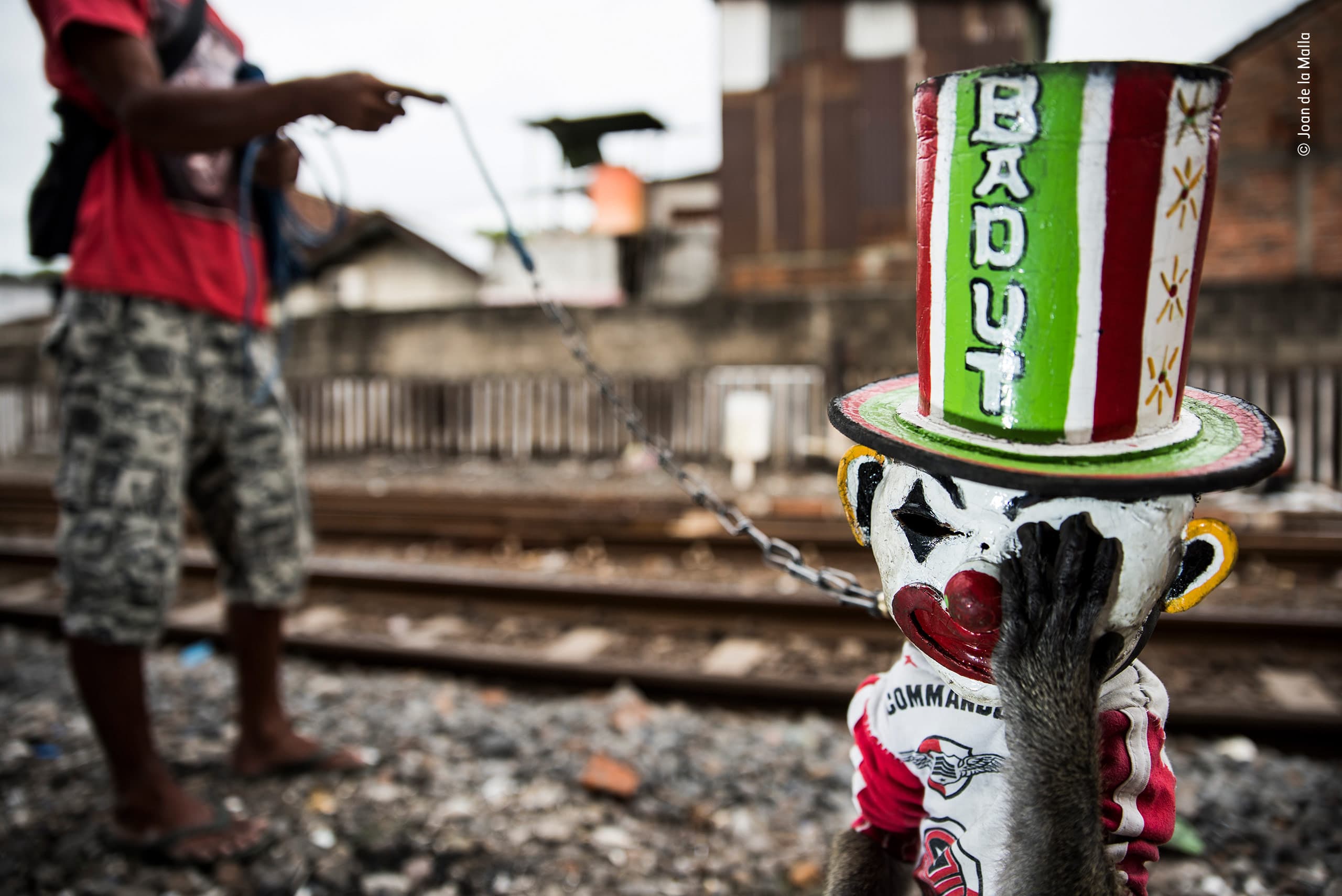
Caption: Timbul, a young long-tailed macaque, instinctively puts his hand to his face to try to relieve the discomfort of the mask he has to wear. His owner is training him to stand upright so that he can add more stunts to his street show repertoire (the word Badut on the hat means clown). When he’s not training or performing, Timbul lives chained up in his owner’s yard next to a railway track in Surabaya, on the Indonesian island of Java. Should he show aggression as he gets older, his teeth might be pulled out or he will just be disposed of. Macaque street shows are banned in several cities, but still take place elsewhere in Indonesia. The macaques often work for hours performing tricks such as dancing and riding bikes. When the owners themselves aren’t working, they might rent out the monkeys. Animal-welfare charities are working at both political and community level to reduce the suffering of these monkeys and to enforce legislation that makes it illegal to take young monkeys from the wild or trade in them without a permit. But the welfare issues reflect other, deeper problems of social justice. Joan spent a long time gaining the trust of the monkey owners in Surabaya. ‘They are not bad people,’ he says, ‘and by doing street shows, they can afford to send their children to school. They just need other opportunities to make a living.’
Nikon D810 + 24–70mm f2.8 lens; 1/250 sec at f2.8; ISO 100; Speedlight SB-800 flash.
City Fisher by Felix Heintzenberg, Germany / Sweden
(Highly Commended, Urban Wildlife)
Chosen by Victoria Hiscock
My favourite photo was of the Kingfisher sat by the wall of graffiti because for me this is an important reminder that wildlife is everywhere. I live in a fairly built up town but I do not need to drive miles into the countryside to find photo opportunities. When you hear ‘urban wildlife’ you often think of foxes and crows, so it was great to see this shot of two different worlds combined. And so beautifully well done too.
www.heintzenberg.com
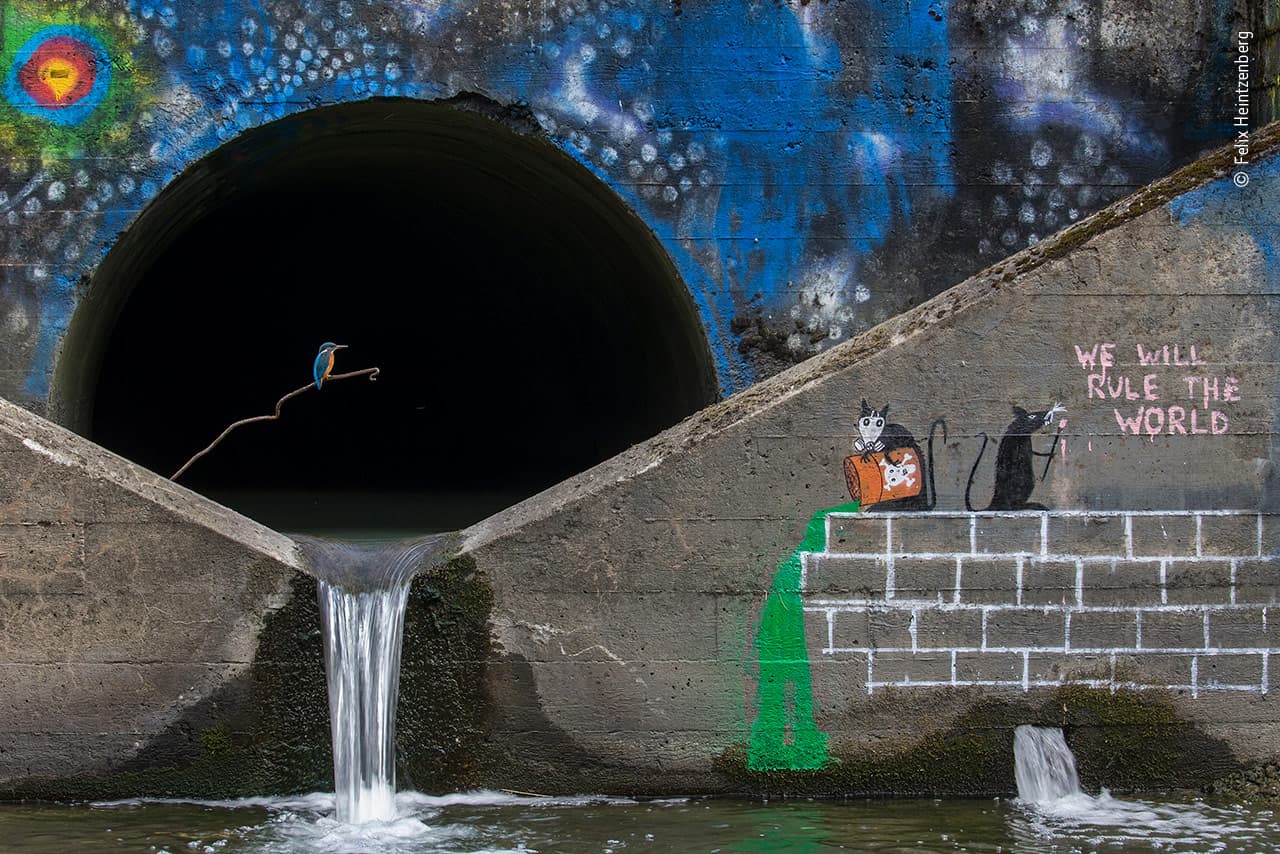
Caption: The rusty metal rod at the opening of a sewerage outlet pipe was a favourite perch for kingfishers, giving them a view of the fish below. Felix visited the spot many times to study them. Seeing the photographic potential of the colourful scene, he used a gentle flash to highlight this particular bird against the dark opening.
Excellent hunters, kingfishers are also good indicators of high water quality. With better water treatment and bans on pollutants in some cities, these birds are slowly returning to urban areas. Kingfishers can struggle to find natural fishing perches in cities and so use whatever they can find, including shopping trollies and scrap metal.
Canon EOS-1D X + 100–400mm f4.5–5.6 lens at 110mm; 1/25 sec at f14; ISO 100; Speedlite 580EX II flash + two 540EZ flashes; Tripod; Pocket Wizard Plus II transceiver; Hide
The Upside Down Flamingoes by Paul Mckenzie , Ireland/Hong Kong
(Highly Commended, Creative Visions)
Chosen by Tash Berbank
For me this photo inspires me to look at wildlife photography in a more abstract way. As an amateur, it is easy to get into the habit of taking portraits of animals, focusing on the eyes, so this really stands out as it breaks those conventions. The unique way Mackenzie encapsulates the sense of a bustling crowd on a hazy summers day makes me want to get out with my camera and try something new myself. www.wildencounters.net

Caption: Flying over the Southern Ewaso Ng’iro River delta, on the border of Kenya and Tanzania, Paul was mesmerized by the network of tendrils, tinged green with algae, spreading through the river sediment. A far fainter latticework traced the trails made by lesser flamingos as they fed. Every year for the past 12 years, Paul has flown over the delta, observing its constant reshaping due to fluctuating rainfall and deposits of silt and sand. Flowing south through Kenya, the river empties into the caustic waters of Lake Natron in northern Tanzania, a major breeding site for lesser flamingos, which rely on the river’s fresh water for drinking and for cleaning the salt from their feathers. As his small plane flew over the fern one final time, Paul framed his shot through the open door, battling against turbulence to capture nature’s silt and water composition.
Canon EOS 5D Mark IV + 24–105mm f4 lens at 32mm; 1/5000 sec at f4; ISO 400.
Argentine Quickstep by Darío Podestá, Argentina
(Highly Commended, Animal Portraits)
Chosen by Anastasia Symecko
What I realised while at the Wildlife Photographer of the Year exhibition was that I really value when (bear with me) a photograph has a ‘sound effect’ in my head. For that reason, my favourite image was “Argentine Quickstep” by Darío Podestá. Standing there looking at the photograph, I could hear the tiny slaps of the plover’s feet on the ground, contrasted against the bleak, scorching silence of the salt field. To me, it’s that ability to elicit a visceral, multi-sensory reaction that makes a great image. www.dariopodesta.com

Caption: Surveying the scene, Darío was captivated by ‘the fragility of the chick’ as it used its oversized legs to scurry after its parents. After an uncomfortable crawl through a salt field in the rain and mud, Darío trained his lens on the speckled fluff of the chick, framing it against the dramatic background of salt and sky.
Two-banded plover chicks will leave their nests almost immediately after they hatch, relying on their stilt-like legs to keep pace with their parents and to evade potential predators. Their long legs also keep their soft down away from the wet ground. After four or five weeks, they will grow large enough to fly away from the care of their mother and father.
Canon EOS-1D X + 300mm f2.8 lens + 2x extender; 1/1600 sec at f5.6 (+1.3 e/v); ISO 1000
The Ice Pool by Cristobal Serrano
Winner, Creative Visions
Chosen by Beata Moore
It didn’t take me long to decide which image was my favourite – “The Ice Pool” image by Cristobal Serrano taking me into a pristine, remote place untouched by human presence is my choice. The spectacular heart-shaped pool in the iceberg and the contrast between the blue centre and dark ocean speaks to me with a powerful voice. Shapes and forms created by nature combined with the precision of composition and superb placement of all the elements allowed me to engage deeply with this remote landscape. It is an image that I will not forget quickly. www.cristobalserrano.com
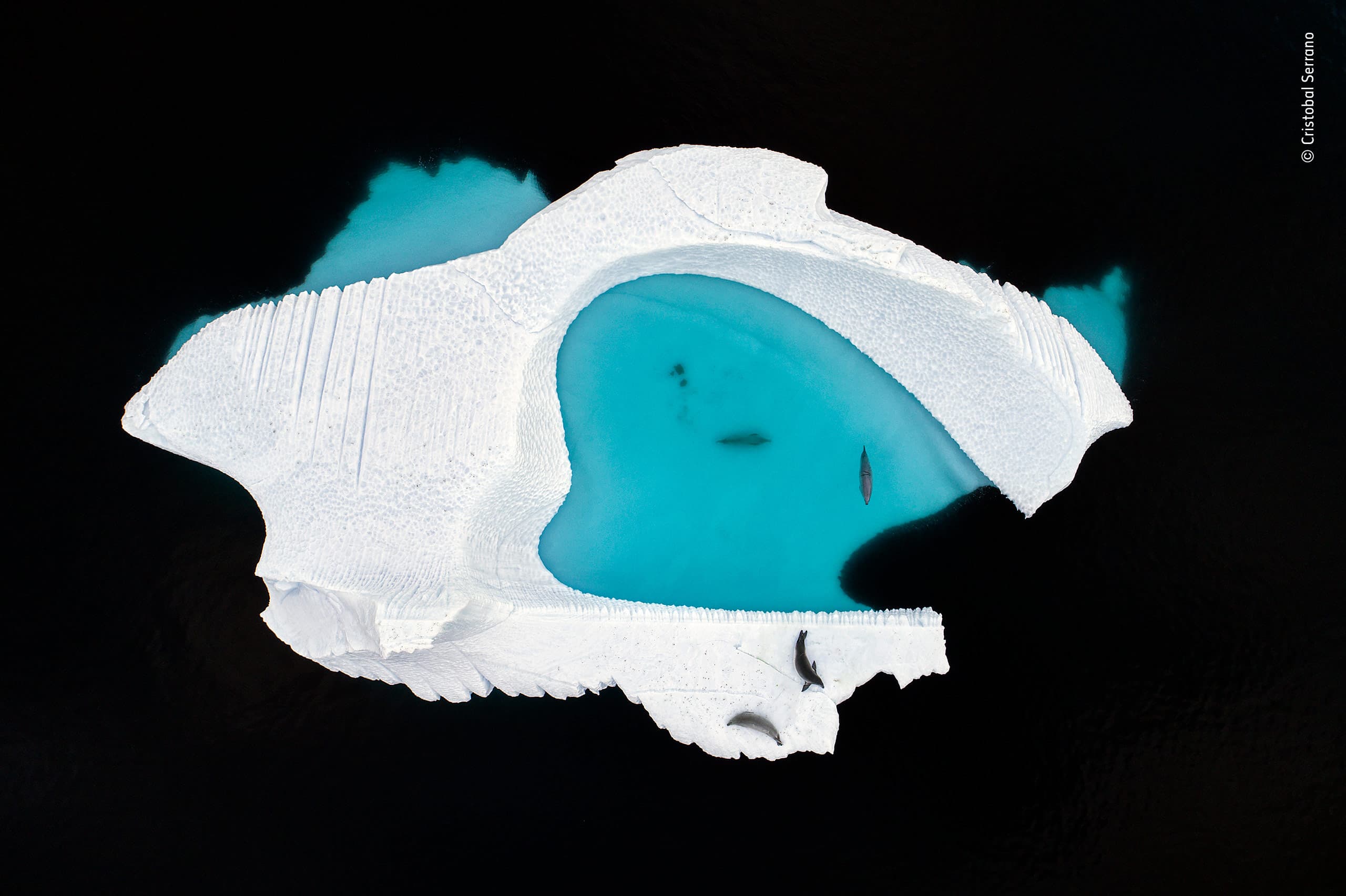
Caption: On a cloudy day – perfect for revealing textures of ice – Cristobal scoured the Errera Channel on the west coast of the Antarctic Peninsula. The constant current through this relatively calm stretch of water carries icebergs of all shapes and sizes. These mighty chunks of frozen fresh water have broken off (calved) from glaciers, ice shelves or larger icebergs. Their beauty – towering above the water and looming even larger beneath – is familiar, but their impact from above, less so. Selecting one that looked promising – about 40 metres (130 feet) long and rising up to 14 metres (46 feet) tall) – Cristobal launched his low-noise drone and flew it high over the top, so as not to disturb any wildlife that might be using it for resting. The drone’s fresh perspective revealed an ice carving, whittled by biting winds and polar seas. Warmer air had melted part of the surface to create a clear, heart-shaped pool, within the sweeping curves of ice. The sculpture was set off by the streamlined forms of a few crabeater seals, in dark shades following their summer moult, and simply framed by the deep water.
DJI Phantom 4 Pro Plus + 8.8–24mm f2.8–11 lens; 1/120 sec at f4.5; ISO 100.
Kuhirwa Mourns Her Baby, by Ricardo Nunez Montero, Spain
(Winner, Behaviour: Mammals)
Chosen by Diane Le Count
I thoroughly enjoyed the Wildlife Photographer of the Year event and within seconds I found my favourite image. ‘Kuhirwa Mourns Her Baby’ is tragic in its story and beautifully portrayed. A young female mountain gorilla is seen not giving up on her dead baby. This visible expression of grief reminds me so much of my daughter who recently gave birth to her baby boy in the knowledge that his heart had already stopped beating in the womb at six months. Just like Kuhirwa, Emma swaddled, cuddled, held and loved her precious baby for as long as she was allowed. www.ricardonmphotography.com

Caption: Kuhirwa, a young female member of the Nkuringo mountain gorilla family in Uganda’s Bwindi Impenetrable Forest, would not give up on her dead baby. What Ricardo first thought to be a bundle of roots turned out to be the tiny corpse. Forced by the low light to work with a wide aperture and a very narrow depth of field, he chose to focus on the body rather than Kuhirwa’s face. Guides told him that she had given birth during bad weather and that the baby probably died of cold. At first Kuhirwa had cuddled and groomed the body, moving its legs and arms up and down and carrying it piggyback like the other mothers. Weeks later, she started to eat what was left of the corpse, behaviour that the guide had only ever seen once before. Kuhirwa’s initial reactions to her bereavement echo responses to death seen in other species. From elephants stroking the bones of dead family members to dolphins who try to keep dead companions afloat, there is an abundance of credible evidence that many animals – ranging from primates and cetaceans to cats, dogs, rabbits, horses and some birds – behave in ways that visibly express grief, though individual reactions vary. Kuhirwa’s behaviour can be understood as mourning, without the need to speculate about her thoughts.
Nikon D610 + 70–300mm f4.5–5.6 lens at 185mm; 1/750 sec at f5; ISO 2200.
Ghost Colony by Jayesh Joshi, India
(Highly Commended, Black and White)
Chosen by Steve Newbold
What is the subject of the photograph? Is it an observation on a human mono-culture of a music festival village or a refugee camp at night with lit tents spread across the land? The sense of emptiness of a human environment is conveyed to the viewer. Reading the text, no this takes that sense of emptiness and human effect on the environment to another level. Flamingo eggs in nests abandoned as far as the eye can see due to the presence of humans. A truly powerful and thought provoking image. www.trailsofjj.com
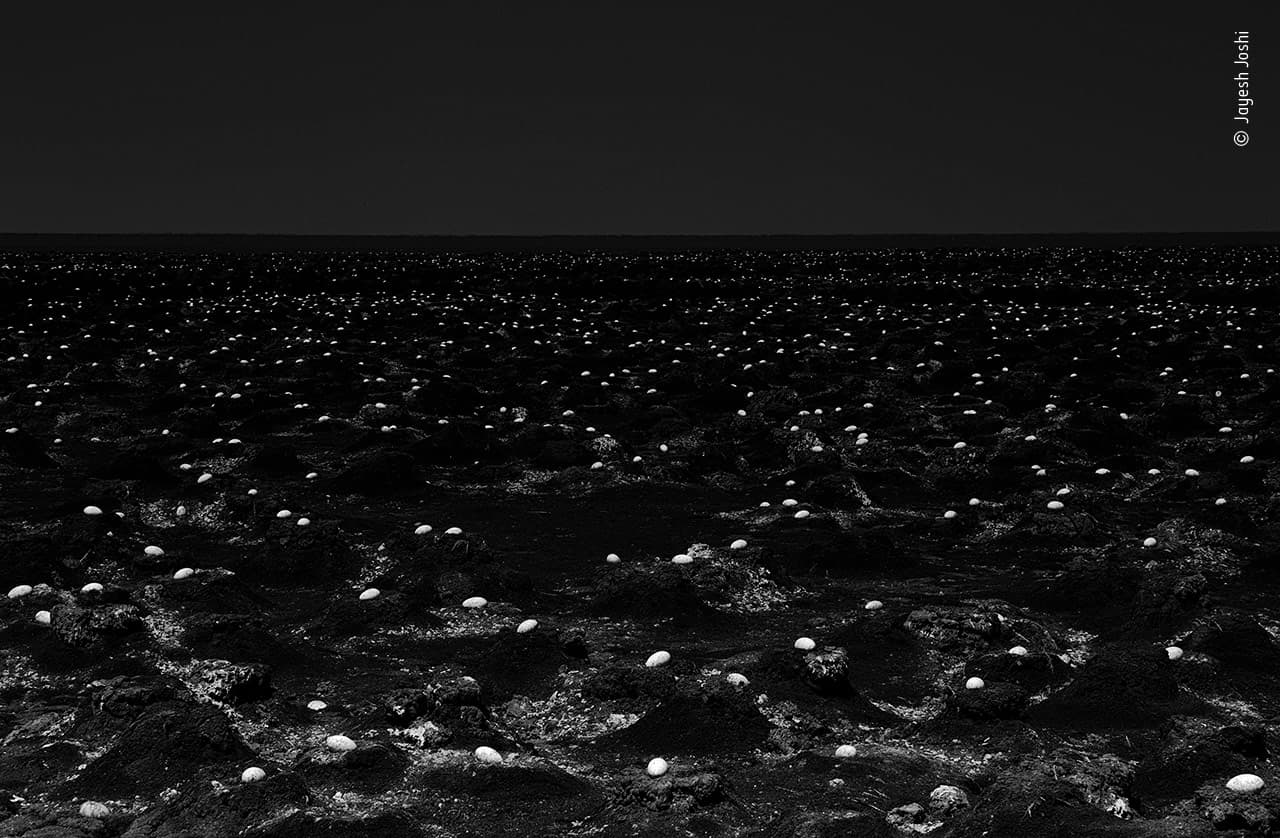
Caption: Abandoned eggs extended as far as the eye could see, their chalky whiteness contrasted against the backdrop of the salt desert. The flamingos that left them had been forced to abandon their nests, after low rainfall brought the early arrival of salt pan workers. Jayesh remarks how he converted his image to black-and-white to ‘convey a melancholic mood’.
Lesser flamingos have always nested on salt pans, as they provide a safe environment away from predators where the birds can feed on the shells and plankton found in the water. This lifeless landscape is a stark reminder of the impact human disturbance and habitat loss can have on flamingos, whose populations continue to decline.
Canon EOS 6D + 24–105mm f4 lens at 90mm; 1/50 sec at f22; ISO 100; Gitzo tripod + Manfrotto ballhead
Witness by Emily Garthwaite
(Highly Commended, Wildlife Photojournalism)
Chosen by Jenny Hodge
My favourite picture from the Wildlife Photographer of the Year collection was of the Sun bear behind bars. I feel it portrays the terrible sadness and torture of this dreadful industry, but at the same time is invaluable for raising awareness of the subject (bear bile farming), which is still relatively unknown as an animal welfare issue. So although it is a very hard image to look at, it’s vital for communicating the topic. Congratulations to the photographer. www.emilygarthwaite.com
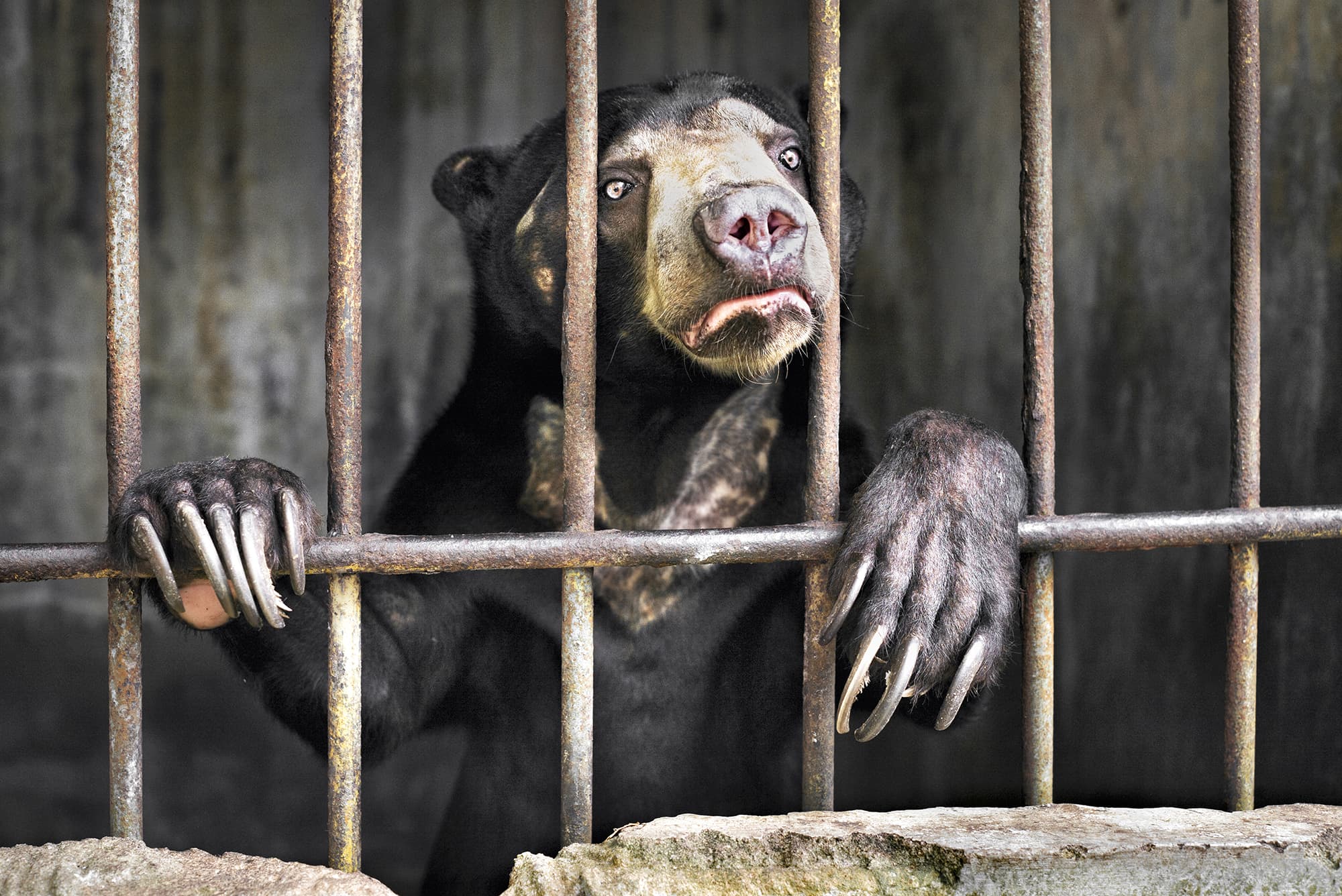
Caption: When Emily approached, the young sun bear hurried to the front of its filthy zoo cage, seemingly eager to interact with her. Yet when it spotted its keeper, its demeanour changed. As the keeper poked and provoked the bear ‘he started screaming,’ said Emily. ‘I’ve never heard such an awful noise, it was very frightening.’
Sun bears are the world’s rarest bears, yet are commonly exploited for their gall bladders and bile. In traditional Chinese medicine the bile is thought to treat a range of ailments, from hangovers to hepatitis. Cubs are farmed, sometimes living permanently with a catheter used to drain the bile.
Leica M240 + Zeiss Distagon T* 35mm f2 lens; 1/125 sec at f5.6; ISO 1000
Smoke Bath by Tom Kennedy, Ireland
(Highly Commended, Urban Wildlife)
Chosen by Lorraine Milligan
The stark monochromatic treatment of this image, with the black rook looking down on the viewer, surrounded by smoke, its eyes hidden imbues it with a dark, menacing symbolism. Is he a messenger for the Grim Reaper? The wires of the chimney pot merge with the feet of the rook to resemble freakish, long talons. This could be a poster for a gothic horror film, or a still from Game of Thrones. If I looked out of the window and saw this I’d feel a cold shiver and probably wouldn’t leave the house for the rest of the day.

Caption: Tom saw the rook as he glanced out of his living room window. Wings spread, the bird was using the neighbour’s chimney pot to smoke bathe. Realising the opportunity – and knowing the heat and smoke would only allow the rook to remain for a few minutes – he quickly took his photograph before leaving it to enjoy its smoky bath. Rooks are incredibly intelligent creatures and smoke bathing is likely to be a learned behaviour, rather than instinct. The smoke helps the birds to fumigate their feathers, ridding them of irritating parasites such as lice, mites and ticks. The related jackdaw has even been seen fumigating itself over smouldering cigarette ends.
Panasonic Lumix DMC-FZ200 + 108mm lens; 1/400 sec at f4; ISO 100
Mister Whiskers, by Valter Bernardeschi, Italy
(Highly commended, Animal Portraits)
Chosen by Angela Nicholson
I was instantly drawn to this image because of the closeness of the walruses and the wide-angle view. Valter shot from water level and this makes me I feel like I’m in amongst the animals, bobbing about in the icy water. I can imagine popping my head up out of the water and reaching out to touch those thick whiskers around the snout of the nearest walrus. Capturing the animals from below has made their turned-down mouths visible, which somehow makes them seem more human to me. www.ilmiocantolibero.com

Caption: It was a bright summer’s night when Valter came across the walruses. They were feeding just off an island in the Norwegian archipelago off Svalbard. Putting on his wetsuit, and using a couple of monopod poles and a float to extend his camera in front of him, Valter slipped into the icy water. Immediately, a few curious walruses – mainly youngsters – began swimming towards him. Clumsy on land, these weighty giants now moved with ease and speed. Keeping at pole’s length, he was able to take this intimate portrait of the distinctive whiskered faces of a youngster and its watchful mother. Walruses use their highly sensitive whiskers and snout to search out bivalve molluscs (such as clams) and other small invertebrates on the ocean floor. In the cold water, their thick protective skin appears grey when blood flow to its surface is reduced, but darker, reddish brown when they are out of water and have warmed up. The tusks are not used for feeding but for display among the males, for defence against polar bears and for hauling themselves out, especially onto sea ice. They will rest on ice floes between bouts of feeding and even give birth on them.
Sony ILCE-7RM2 + 28mm f2.8 lens + ultrawide converter; 1/800 sec at f8; ISO 1250; Nimar II housing; Nikonos remote control; Feisol monopod.
Ahead in the Game by Nicholas Dyer, UK
(highly Commended,, Behaviour: Mammals)
Chosen by Martin Fisher
This picture is shocking but is an important reminder that alongside the beauty and awe of the natural world is the casual cruelty and lack of sentimentality. The human-like face of the baboon, its eyes closed and teeth gritted at the point of death, is uncomfortable to look at but its all part of the circle of life, to quote my favourite Disney film. www.nicholasdyer.com/
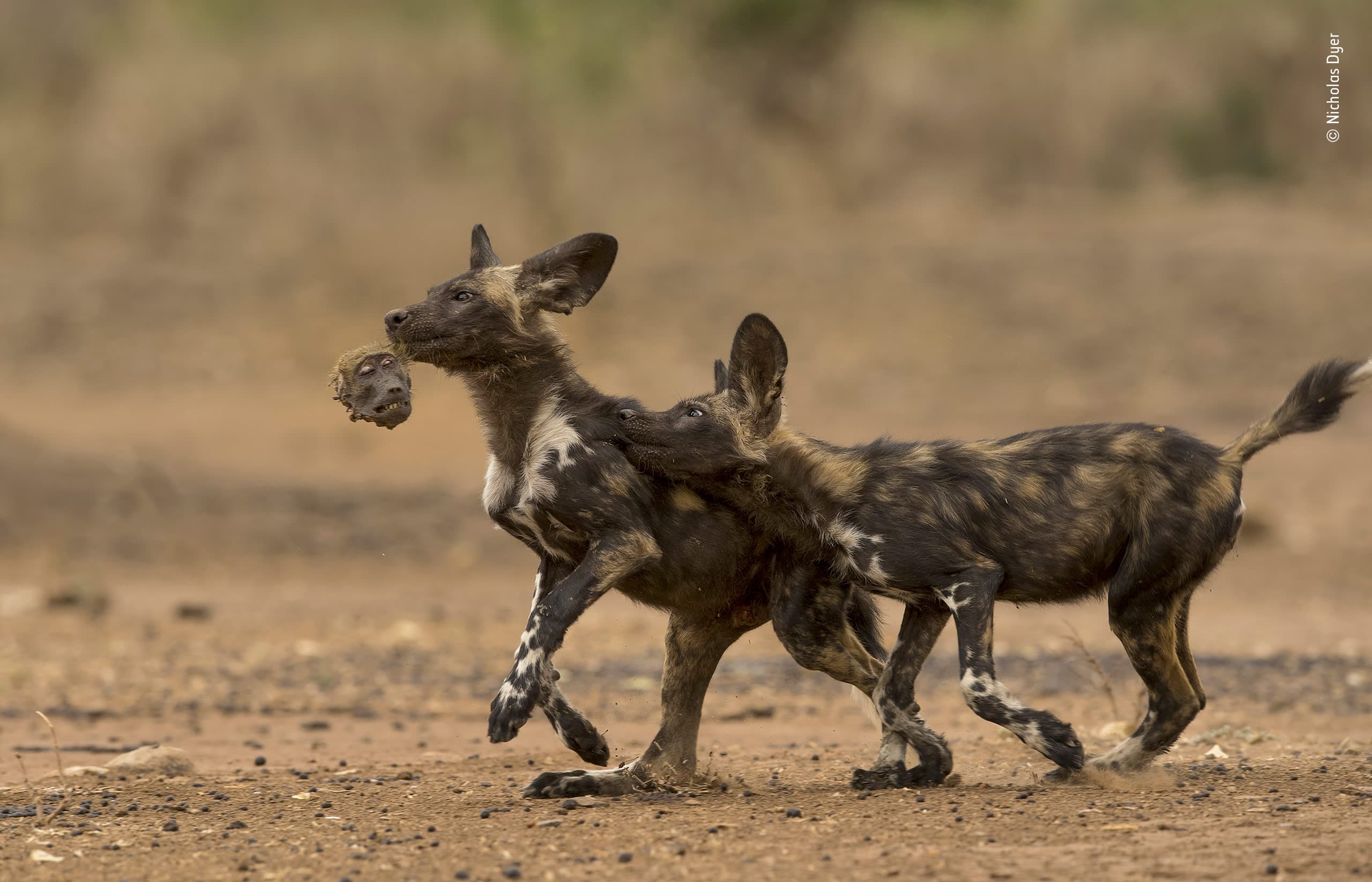
Caption: A pair of African wild dog pups play a macabre game of tag with the head of a chacma baboon – the remains of their breakfast. The endangered African wild dog (aka the painted hunting dog) is best known for hunting antelopes, such as impalas and kudus. But over the past five years, in Mana Pools National Park, northern Zimbabwe, Nick has witnessed three different packs regularly killing and eating baboons – highly unusual, not least because baboons are capable of inflicting severe wounds. The hunting technique has been perfected by Blacktip, mother of the pups and the alpha female of the Nyakasanga pack. That morning, Nick had tracked a pack on foot for 3 kilometres (nearly 2 miles), taking in two failed impala hunts before the dogs finally seized a baboon. It wasn’t enough to feed the whole pack, but it satisfied nine pups. They stopped short of the baboon’s skull, and then the fun began. Nick, lying nearby, watched more than half an hour of chasing, tackling and tugs of war with the leftovers.
Nikon D5 + 400mm f2.8 lens; 1/640 sec at f5.6 (-0.6 e/v); ISO 800; Redged tripod +
Wimberley head.





